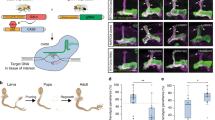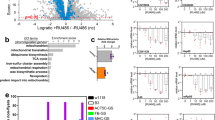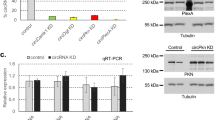Abstract
THE ability to isolate gene sequences and analyse their expression patterns has generated demand for mutations created to assess their biological functions. In Drosophila melanogaster this can be achieved by traditional mutagenesis, but this is time-consuming, labour-intensive and not always successful. Moreover, the functions of genes that are expressed several times during develop-ment are often obscured in the later stages because of disruptions caused by the absence of early gene function. Here we propose a new strategy to create conditional knock-out mutations using a targeted heat-inducible ribozyme. Ribozymes are catalytic RNA molecules that specifically cleave RNAs1–11 and are potentially useful for studying gene function during animal development because the expression of critical regulatory genes is usually low and their function is often dosage-dependent. The ribozyme can be delivered to a specific region or at a particular developmental stage using a region-specific or inducible promoter. The Drosophila fushi tarazu (ftz) gene is a good candidate for testing this approach12–17. We generated transgenic flies carrying a ribozyme against the ftz gene. The two developmental phases of ftz function can be distinguished by timed induction of the ribozyme. Activation of the ribozyme in the blastoderm disrupts the ftz seven-stripe pattern and produces ftz-like pair-rule defects in larvae. The involvement of ftz in neurogenesis was verified by activation of the ribozyme during the early phase of formation of the central nervous system.
This is a preview of subscription content, access via your institution
Access options
Subscribe to this journal
Receive 51 print issues and online access
$199.00 per year
only $3.90 per issue
Buy this article
- Purchase on Springer Link
- Instant access to full article PDF
Prices may be subject to local taxes which are calculated during checkout
Similar content being viewed by others
References
Cech, T. R. Science 236, 1532–1539 (1987).
Forster, A. C. & Symons, R. H. Cell 49, 211–220 (1987).
Haseloff, J. & Gerlach, W. L. Nature 334, 585–591 (1988).
Uhlenbeck, O. C. Nature 328, 596–600 (1987).
Ruffner, D. E., Stormo, G. D. & Uhlenbeck, O. C. Biochemistry 29, 10695–10702 (1990).
Cotten, M. & Birnstiel, M. L. EMBO J. 8, 3861–3866 (1989).
Cameron, F. H. & Jennings, P. A. Proc. natn. Acad. Sci. U.S.A. 86, 9139–9143 (1989).
Sarver, N. et al. Science 247, 1222–1225 (1990).
L'Huillier, P. J., Davis, S. R. & Bellamy, A. R. EMBO J. 11, 4411–4418 (1992).
Zheng, X. & Whitton, J. L. J. Virol. 66, 1361–1369 (1992).
Stelnecke, P., Herget, T. & Schreier, P. H. EMBO J. 11, 1525–1530 (1992).
Laughton, A. & Scott, M. P. Nature 310, 25–31 (1984).
Carroll, S. B. & Scott, M. P. Cell 43, 47–57 (1985).
Wakimoto, B. T., Turner, F. R. & Kaufman, T. C. Devl Biol. 102, 147–172 (1984).
Weiner, A. J., Scott, M. P. & Kaufman, T. C. Cell 37, 843–851 (1984).
Hafen, E., Kuroiwa, A. & Gehring, W. J. Cell 37, 833–841 (1984).
Doe, C. Q., Hiromi, Y., Gehring, W. J. & Goodman, C. S. Science 239, 170–175 (1988).
Karr, T. L. & Kornberg, T. B. Development 105, 95–103 (1989).
Furukubo-Tokunaga, K. et al. Genes Dev. 6, 1082–1096 (1992).
Patel, N. H., Schafer, B., Goodman, C. C. & Holmgren, R. Genes Dev. 3, 890–904 (1989).
Hiromi, Y. & Gehring, W. J. Cell 50, 963–974 (1987).
Pirotta, V. in Vectors: A Survey of Molecular Cloning Vectors and their Uses (eds Rodriguez, R. L. & Reinhardt, D. T.) 437–456 (Butterworths, Boston, 1988).
Karess, R. E. & Rubin, G. M. Cell 38, 135–146 (1984).
Rubin, G. M. & Spradling, A. C. Science 218, 348–353 (1982).
Jürgens, G., Wieschaus, E., Nüsslein-Volhard, C. & Kluding, H. Roux's Arch. dev. Biol. 193, 283–295 (1984).
Zhao, J. J., Lazzarini, R. A. & Pick, L. Genes Dev. 7, 343–354 (1993).
Author information
Authors and Affiliations
Rights and permissions
About this article
Cite this article
Zhao, J., Pick, L. Generating loss-of-function phenotypes of the fushi tarazu gene with a targeted ribozyme in Drosophila. Nature 365, 448–451 (1993). https://doi.org/10.1038/365448a0
Issue Date:
DOI: https://doi.org/10.1038/365448a0
This article is cited by
-
Shortcuts from gene sequence to function
Nature Biotechnology (1999)
-
Antisense approaches to the gene therapy of cancer-?Recnac?
Cancer and Metastasis Review (1996)
Comments
By submitting a comment you agree to abide by our Terms and Community Guidelines. If you find something abusive or that does not comply with our terms or guidelines please flag it as inappropriate.



